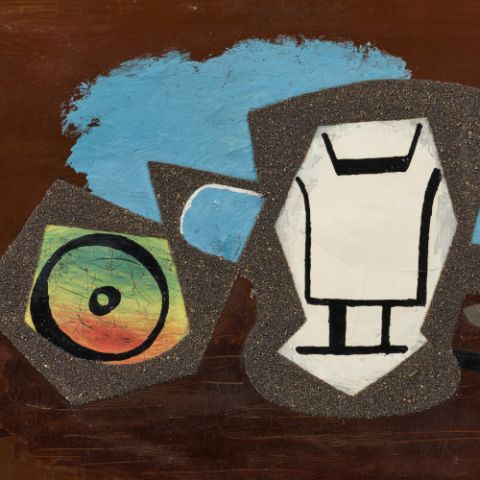
Lot 7 | Gerhard Marcks | Alcina I
1889 Berlin - 1981 Burgbrohl
Title: Alcina I.
Date: 1934 (draft).
Technique: Bronze, brown-patinated.
Measurement: 110 x 39 x 24cm.
Notation: Artist's signet at the back of the hem. Here additionally inscribed: 1.
Foundry Mark: Beside it foundry mark H. NOACK BERLIN FRIEDENAU.
This bronze is one of two copies of the frist edition.
Provenance:
- Buchholz Gallery/Curt Valentin, New York
- Collection Morton D. Day, Saint Louis
- Collection Laura Bramlette, Houston
- Privatsammlung Nordrhein-Westfalen
Literature:
- Busch, Günter/Rudloff, Martina: Gerhard Marcks - Das plastische Werk. Mit einem Werkverzeichnis von Martina Rudloff, Frankfurt a.MBerlin/Vienna 1979 (2nd ed.), cat. rais. no. 290, ill.
- Titled after an opera by Georg Friedrich Händel, which connects the artist and the model
- The model for the sculpture was Trude Jalowetz, whom Marcks met during his time in Halle/Saale
- All-round exciting sculpture with fine details and contours and a strong spatial presence
The basics of sculpture
After directing the pottery workshop at the Bauhaus in Weimar, Gerhard Marcks (1889-1981) moved to the Burg Giebichenstein in Halle in 1925. In his discussions with his fellow painters at the Bauhaus, in particular Lyonel Feininger (1871-1956), he had begun to examine the fundamentals of sculpture. Just as the painters at the Bauhaus addressed line, colour, surface and contrast in their work, he explored the basic categories of his medium: volume, negative space and sculptural contrasts between concave and convex, between flat and round, between surfaces and edges. Feininger, in particular, encouraged him to believe that these abstract categories and the representation of reality are by no means mutually exclusive (as the more radical artists at the Bauhaus claimed), but can in fact reinforce each other. This attitude led him to discover archaic Greek sculpture and the work of Auguste Rodin (1840-1917). The next step was the development of a kind of artistic programme that he would adhere to until his death: the aim was to achieve a balance between sculptural form and living nature in each individual work.
In 1931, Marcks was the youngest sculptor to be shown in the ‘German Painting and Sculpture’ exhibition at the Museum of Modern Art in New York, and at the end of 1932, the renowned Flechtheim Gallery in Berlin presented his work in a major exhibition. His rise ended in April 1933, when he was dismissed by the new National Socialist rulers. In the years that followed, an art policy emerged in Germany in which he was considered ‘degenerate’. Firstly, he was regarded as a hated modern artist of the Weimar Republic. Secondly, his art eluded racist instrumentalisation because he did not idealise and emphasised the simplified form.
"Alcina"
Marcks preferred models from his immediate surroundings, family, friends, colleagues and students. The aim was not to repeat the traditional poses of academic tradition, but to find a modern expression in the sense of Rodin. Between 1931 and 1935, Marcks created 29 sculptures based on Trude Jalowetz (1910-1976), a student in the weaving class at Burg Giebichenstein who, as a Jew, had to leave the country in 1933. Shortly afterwards, he visited her in the Netherlands and there he created the drawings from which he developed the two versions of ‘Alcina’ in 1934, back in Germany. Marcks drew from the model to find striking outlines, which he then - without a model - transformed into plastic forms. Typical of Marcks in ‘Alcina’ is the way he places the arms on the body and connects them without interruption to the large volume of the garment. Seen from the front, the posture of the standing woman shines through; from behind, the abstract play with the large vertical folds of the garment dominates. If you walk around the sculpture slowly, step by step, you will discover how the observation of nature repeatedly shines through, especially over the outlines. The most striking realistic detail is the frilled sleeves of the dress (which can thus be explicitly identified as a nightgown), which Marcks changed in the second version (also from 1934), along with the woman's hairstyle. The title quotes an opera by Georg Friedrich Handel (1685-1759) and refers melancholically to the time they had spent together in Halle, when a record of the ‘Alcina Suite’ (the overture and dances from the opera) was often played in the sculptor's apartment.
Works by Trude Jalowetz were exhibited in Germany until the 1940s. A small network of modern art enthusiasts supported Marcks under the conditions of the dictatorship and until 1941 he was also able to sell to the United States, where some of his Jewish collectors had fled. Curt Valentin (1902-1954), a former employee of Flechtheim's, opened the Buchholz Gallery in New York in 1937 and, as far as can be reconstructed today, the first cast of ‘Alcina’ presented at the auction came to the collection of department store owner Morton D. May (1914-1983) in St. Louis via Valentin in the late 1940s.
Arie Hartog
Print this lot | Recommend lot |
Conditions of this Lot
32% buyer’s premium on the hammer price
Estimated shipping costs for this lot:
Arrangement after the auction.
Gerhard Marcks Germany Bauhaus Modern Art Sculptures 1930s Figure / Figures Object Bronze Woman
More lots which could be of your interest
- Estimate: 10.000 - 15.000 €
04.12.2025 - ca.10:35Modern | Post War | Contemporary | Galerie Thomas | The Jagdfeld Collection | Auction 03.12.2025 - Estimate: 6.000 - 8.000 €
04.12.2025 - ca.10:36Modern | Post War | Contemporary | Galerie Thomas | The Jagdfeld Collection | Auction 03.12.2025











